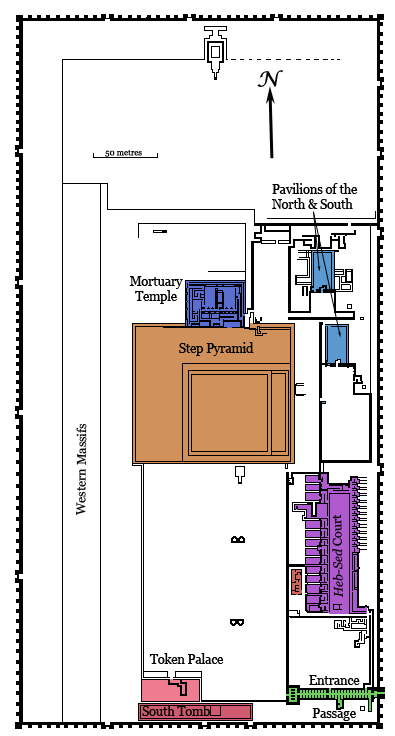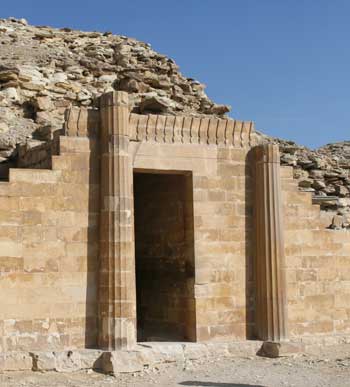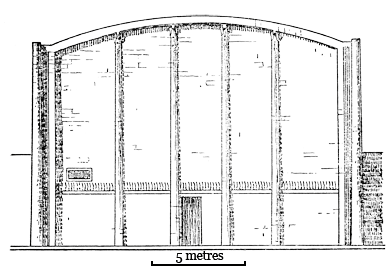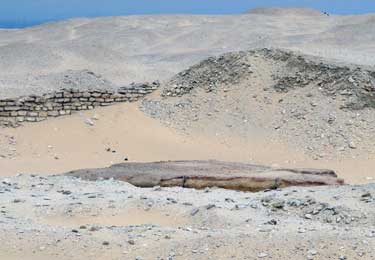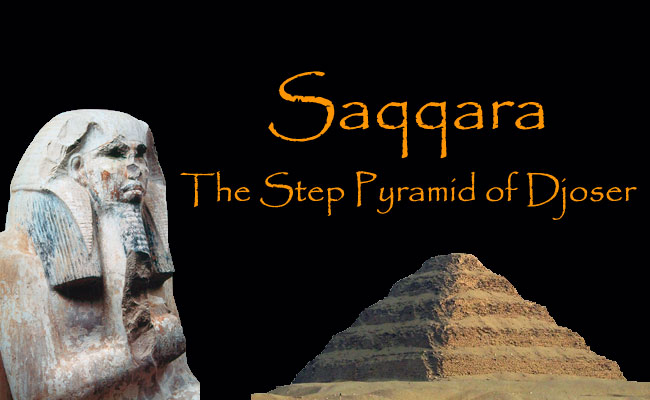
The Houses of the North and South
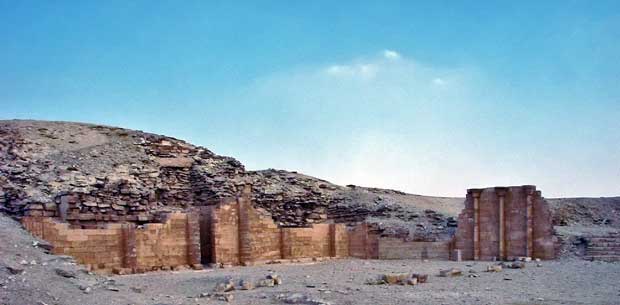
The House of the North
A narrow passage in the northwest corner of the Heb Sed Court leads to two long courtyards lying to the east of the step pyramid. They were separated by an north-south wall with a stone door (open, of course) permitting access between them. At the far end of the eastern court is a structure known as the House of the South and beyond it, another courtyard with a similar building, the House of the North. It is generally believed that the two buildings are stone versions of the temporary pavilions used by the pharaoh during the Heb-Sed, perhaps representing the White House of Upper Egypt and the Red House of the Delta.
The design of the two buildings is very similar in appearance to the per wer chapels of the Heb Sed Court although they are larger and more elaborate. The House of the South has the same vaulted roof and tapering, fluted columns with pendant, leaf-like capitals. The tallest of these has been estimated to have been about 12 metres high. The corners were supported by ribbed pilasters
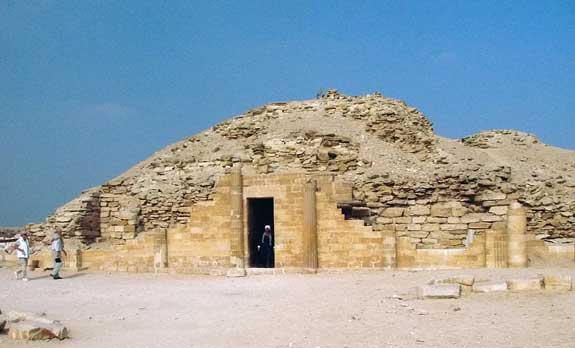
House of the South
(in other words, they are rectangular in section) next to two semi-circular fluted shafts. The doorway is off-centre, clinging to one of the columns. Above the doorway is what is known as a 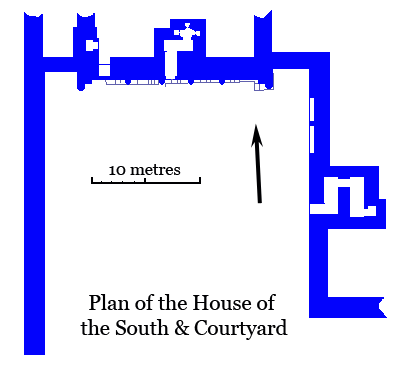 kheker frieze that Lauer believed represented a rope of knotted grass but is more likely to have been based on the fringe of a mat or carpet.
kheker frieze that Lauer believed represented a rope of knotted grass but is more likely to have been based on the fringe of a mat or carpet.
The interior of what is otherwise a solid mass of masonry, consists of a narrow passage that makes two 90 degree turns leading to a small cruciform chamber with niches in the shape of hut-shrines. It has been suggested that the crowns of Upper Egypt were kept here (they had to be kept somewhere).
The courtyard is about 75 metres long and broadens from about 25 to about 40 metres across. The eastern and southern walls were decorated with alternating niches and buttresses. One particularly broad niche in the eastern wall frames a single column, probably with a lotus capital symbolizing Upper Egypt. Next to it is another small chapel with a zigzag corridor leading to what appears to be a small niche while in the southwest corner are 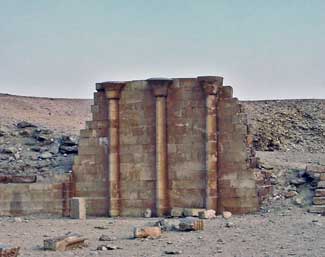 the foundations of a horseshoe-shaped marker, similar to those in the Great Court.
the foundations of a horseshoe-shaped marker, similar to those in the Great Court.
The House of the North (top) is very similar in plan but the courtyard is much reduced in size. The semi-circular shafts at the corners are missing. The corridor is a little longer and contains two niches in addition to the ones in the cruciform chamber. Here too, the archaeologists found a broad niche (right) in the east wall of the courtyard but, in this case, it was much better preserved. The niche contained three papyriform columns, replicas of the plant form that characterized the Delta. There is a slight swelling of the shafts of the stems (entasis), which are triangular in section.
The Northern Court
Most of the northern third of the enclosure was occupied by an open space known as the northern court. The area has not been thoroughly explored and its exact function is unknown, although guesses range from a dump site for building debris to solar temple. There is a large rectangular block of stone 15 metres across with a stairway ramp at the far end of the courtyard, facing the burial chamber of the pyramid. It had been carved out of the bedrock and faced with limestone. On top is a setting 8 metres square and a few centimetres deep that has been interpreted as the setting for a benben stone, after the sacred stone at Heliopolis where the sun’s first rays fell. The
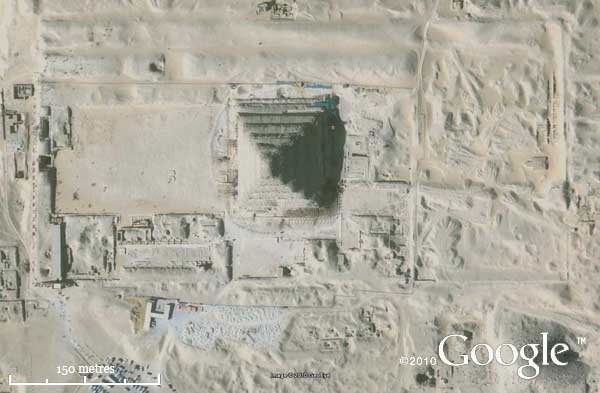 Google Earth View of the Djoser Complex
Google Earth View of the Djoser Complex
solar cult was a prominent feature of later royal tombs and this may be its origins. After all, Imhotep, the second man in the kingdom and royal builder at Saqqara, was the chief priest of Re, the sun god. No trace of any obelisk has been found but the North Court was the last part of the enclosure to be built and was never finished—probably due to the death of the king. Of course, the simplest explanation is that it 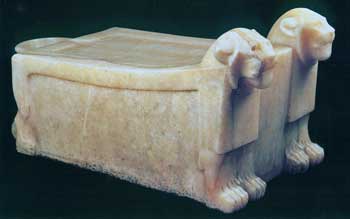 was used as an altar.
was used as an altar.
Stockpiles of grain and fruit (including grapes and sycamore figs) were found in subterranean magazines nearby and two rows of dummy granaries had been built close to the northern enclosure wall. Other galleries found at deeper level appear to antedate the enclosure and may well have belonged to earlier tombs. In one of them was found a small alabaster offering table. Two lions support a tray that slopes gradually down to the back where the lion’s tails curl around a deep vessel to catch the libations or the blood of sacrificial victims.
The Western Massif
Virtually the entire western side of the site is taken up by three long structures, two flat-topped ones flanking a central vaulted one, covering an elaborate network of underground galleries. The layout of the latter very much resembles the subterranean tombs of the Second Dynasty pharaohs, Hotepsekhemwy and Nynetjer found just to the north of the enclosure and there is a very strong suspicion that this might be another one. However, although a large number of stone vessels were recovered here, there is a dearth of inscribed material
THE AFTERMATH
Djoser's son and successor Sekhemkhet built a similar complex at Saqqara and there is evidence of at least two others to the west. Another member of Djoser's dynasty, Khaba, may have started the so-called ‘Layer Pyramid’ at Giza but with the rise to power of the Fourth Dynasty the stepped form gave way to the ‘true’ pyramid.
The practice of building on a monumental scale became standard among the pharaohs who succeeded Djoser and reached its apogee in the Great Pyramid of Khufu at Giza. The political benefits of such projects were obvious. “Idle hands are the devil’s tools.” and the pharaohs were well aware of the dangers of hundreds of thousands of farmers with time on their hands while the Nile was in flood. Not only did the pyramid project keep them busy but it also put them on the state payroll making them more dependent on the central government.
The logistical problems in a project of this scale were unprecedented. Thousands of people needed to be housed and fed. Material and supplies had to be moved from all over Egypt to the building site. The creation of a class of men who could handle such problems gave Egypt the managerial resources to take on any large and complex project— invading another country, for example, or putting together a large trading expedition. In addition, thanks to Imhotep, Egypt had a large pool of highly skilled artists and artisans— stone masons, sculptors, draughtsmen and painters.

